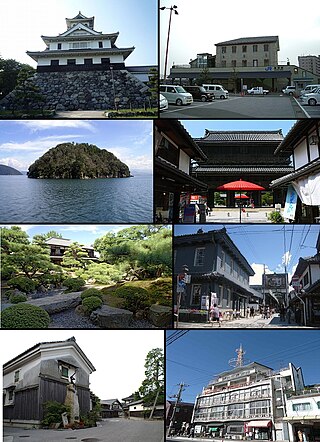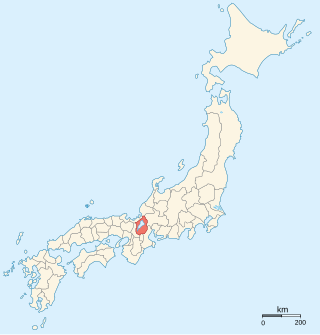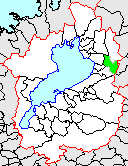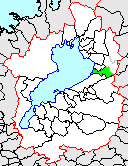
Shiga Prefecture is a landlocked prefecture of Japan located in the Kansai region of Honshu. Shiga Prefecture has a population of 1,412,916 as of 1 October 2015 and has a geographic area of 4,017 km2 (1,551 sq mi). Shiga Prefecture borders Fukui Prefecture to the north, Gifu Prefecture to the northeast, Mie Prefecture to the southeast, and Kyoto Prefecture to the west.

Hikone is a city located in Shiga Prefecture, Japan. As of 1 August 2021, the city had an estimated population of 111,958 in 49066 households and a population density of 570 persons per km². The total area of the city is 196.84 square kilometres (76.00 sq mi).

Nagahama is a city located in Shiga Prefecture, Japan. As of 1 November 2021, the city had an estimated population of 116,043 in 46858 households and a population density of 120 persons per km2. The total area of the city is 680.79 square kilometres (262.85 sq mi).

Kusatsu is a city located in Shiga Prefecture, Japan. As of 31 January 2024, the city had an estimated population of 139,913 in 63,942 households and a population density of 2100 persons per km2. The total area of the city is 67.82 square kilometres (26.19 sq mi). The city is often confused with Kusatsu, Gunma Prefecture, which is a famous hot spring resort.

Ōmi Province was a province of Japan, which today comprises Shiga Prefecture. It was one of the provinces that made up the Tōsandō circuit. Its nickname is Gōshū (江州). Under the Engishiki classification system, Ōmi was ranked as one of the 13 "great countries" (大国) in terms of importance, and one of the "near countries" (近国) in terms of distance from the imperial capital Kyoto.

Maibara Station is an interchange passenger railway station located in the city of Maibara, Shiga, Japan. On the border between West Japan Railway Company and Central Japan Railway Company, it is jointly operated by both companies, along with the private railway operator Ohmi Railway. It is also a freight depot for the Japan Freight Railway Company.

Santō was a town located in Sakata District, Shiga Prefecture, Japan. There was Kashiwabara-juku in Edo period.

Ibuki was a town located in Sakata District, Shiga Prefecture, Japan. Mount Ibuki dominates the town.

Maihara was a town located in Sakata District, Shiga Prefecture, Japan.

Sakata was a district located in Shiga Prefecture, Japan.

Ohmi Railway Co., Ltd. is a Japanese private railway company which operates in Shiga Prefecture, and a member of the Seibu group since 1943. The company is named after the Ōmi Province, the former name of the present-day Shiga. The railway is nicknamed "Gachakon train" by local users because of its noisy sound.

The 69 Stations of the Nakasendō are the rest areas along the Nakasendō, which ran from Nihonbashi in Edo to Sanjō Ōhashi in Kyoto. The route stretched approximately 534 km (332 mi) and was an alternate trade route to the Tōkaidō.

Ōtsu-juku was the last of the sixty-nine stations of the Nakasendō, as well as the last of the fifty-three stations of the Tōkaidō. It was 14 km (9 mi) from the previous post town, Kusatsu-juku, and was located in Ōmi Province. It is currently located in the present-day city of Ōtsu, Shiga Prefecture, Japan.

Kashiwabara-juku (柏原宿) was the sixtieth of the sixty-nine stations of the Nakasendō highway connecting Edo with Kyoto in Edo period Japan. It was located in the present-day city of Maibara, Shiga Prefecture, Japan.

Banba-juku was the sixty-second of the sixty-nine stations of the Nakasendō highway connecting Edo with Kyoto in Edo period Japan. It was located in the present-day city of Maibara, Shiga Prefecture, Japan.

Toriimoto-juku (鳥居本宿) was the sixty-third of the sixty-nine stations of the Nakasendō highway connecting Edo with Kyoto in Edo period Japan. It was located in the present-day city of Hikone, Shiga Prefecture, Japan, overlooking Lake Biwa.

Samegai-juku was the sixty-first of the sixty-nine stations of the Nakasendō highway connecting Edo with Kyoto in Edo period Japan. It was located in the present-day city of Maibara, Shiga Prefecture, Japan.

Musa-juku (武佐宿) was the sixty-sixth of the sixty-nine stations of the Nakasendō highway connecting Edo with Kyoto in Edo period Japan. It was located in the present-day city of Ōmihachiman, Shiga Prefecture, Japan. Other kanji used to write "Musa" included 牟佐 and 身狭, but 武佐 became the official kanji in the Edo period.

Kashiwabara Station is a passenger railway station located in the city of Maibara, Shiga Prefecture, Japan, operated by the Central Japan Railway Company.

Kamaha Castle was a Sengoku period yamashiro-style Japanese castle located in the Banba neighborhood of the city of Maibara, Shiga Prefecture, in the Kansai region of Japan. Its ruins have been protected as a National Historic Site since 2005.























